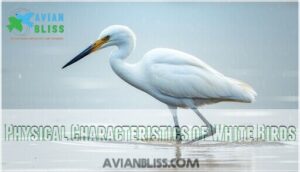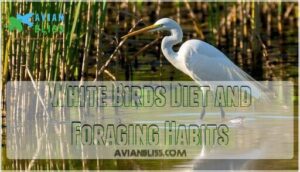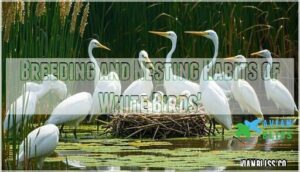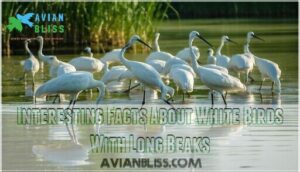This site is supported by our readers. We may earn a commission, at no cost to you, if you purchase through links.

You’ll spot species like the American White Pelican, Great Egret, and White Ibis using their distinctive elongated beaks to snatch fish, crustaceans, and insects with surgical accuracy.
These stunning birds aren’t just beautiful – they’re highly specialized predators adapted to specific environments.
Their long beaks act like specialized fishing tools, probing shallow waters and mudflats with incredible efficiency.
Whether wading through marshes or perched near coastal shorelines, these white-feathered athletes showcase remarkable hunting techniques that’ll make you appreciate their unique evolutionary design.
Table Of Contents
- Key Takeaways
- Types of White Birds With Long Beaks
- Physical Characteristics of White Birds
- Habitat and Distribution of White Birds
- White Birds Diet and Foraging Habits
- Breeding and Nesting Habits of White Birds’
- Migration Patterns of White Birds
- Characteristics of Long-Beaked White Birds
- Identifying White Birds With Long Beaks
- Conservation and Threats to White Birds
- Interesting Facts About White Birds With Long Beaks
- Frequently Asked Questions (FAQs)
- What is a white bird with a long beak?
- What birds have long beaks?
- Do white birds have long beaks?
- Do hummingbirds have long beaks?
- What does a white stork beak look like?
- What bird has the largest beak?
- What is the difference between a white ibis and an egret?
- How many white birds have long beaks?
- Where do white birds with long beaks live?
- What bird has a curved beak?
- Conclusion
Key Takeaways
- You’ll discover white birds with long beaks are precision predators, using their specialized beaks to expertly hunt crustaceans, fish, and insects across diverse wetland ecosystems with remarkable efficiency.
- You’ll learn these birds showcase incredible adaptability, transforming challenging environments like marshes, mudflats, and coastal regions into thriving hunting grounds through unique foraging strategies and evolutionary design.
- You’ll see that migration and breeding habits reveal complex survival techniques, with these birds navigating thousands of miles, building intricate nests, and protecting their young through sophisticated social behaviors and collective strategies.
- You’ll understand these birds face critical conservation challenges, with habitat loss and climate change threatening their populations, making awareness and protection crucial for maintaining the delicate ecological balance they help sustain.
Types of White Birds With Long Beaks
If you’re fascinated by elegant white birds with impressive long beaks, you’re in for a treat.
You’ll discover nine stunning species that inhabit diverse ecosystems, from coastal wetlands to inland marshes, each with unique adaptations that make them masters of their environments.
American White Pelicans
Rarely will you encounter a bird as majestic as the American White Pelican, a remarkable species with an impressive 10-foot wingspan that dominates North American wetlands.
These clever fish herders showcase extraordinary pelican behavior through cooperative foraging techniques.
Their unique characteristics include:
- Massive birds weighing up to 30 pounds
- Impressive 15-inch beaks for precision hunting
- Masters of group fishing strategies
- Perfectly adapted to diverse aquatic environments
- Seasonal migration experts traversing vast landscapes
Their unique plumage variations and conservation status make them true white birds with long beaks champions.
White Ibises
After the pelicans soar away, another white-feathered marvel takes center stage: the American White Ibis. These wading birds are masters of wetland survival, flaunting striking white plumage and a distinctive curved beak.
Their Ibis Habitat spans from coastal marshes to urban parks, where they hunt with precision.
- Navigate shallow waters like pros
- Snag tasty crustaceans with ease
- Adapt to diverse environments effortlessly
Their crimson-faced charm makes them impossible to ignore, with their ability to thrive in various settings being a true wetland survival marvel.
Wood Storks
How do Wood Storks survive in challenging wetland environments? These resilient wading birds stand out with their charcoal-gray heads and pristine white plumage.
With black beaks sensitive enough to snap up prey by touch, they’re masters of stork foraging in shallow waters. Nesting in large colonies, these white birds with long beaks reveal nature’s remarkable adaptations.
Their conservation status remains precarious, highlighting the critical importance of protecting their delicate wetland habitats. A demonstration of survival, Wood Storks continue to captivate wildlife enthusiasts with their unique hunting strategies and remarkable adaptations.
Great Egrets
Imagine a white phantom gliding through marshes, its yellow beak poised like a surgeon’s scalpel—that’s the Great Egret, nature’s masterpiece among white birds with long beaks.
These elegant herons command wetland landscapes with surgical precision in their foraging strategies.
- Witness their breathtaking breeding behavior, transforming landscapes into living canvases
- Marvel at plumage changes that speak volumes about survival
- Experience their silent hunt, a dance of patience and power
- Celebrate their resilience in fragile ecosystem corridors
Standing nearly 3.3 feet tall, Great Egrets represent more than just birds—they’re living symbols of regional variations in wetland ecosystems. Their conservation status tells a story of adaptation, survival, and hope in an ever-changing world.
Snowy Egrets
Dancing through wetlands, the Snowy Egret dazzles with its pristine white plumage and stunning "golden slippers" – bright yellow feet that stir up prey with remarkable precision.
These elegant white birds with long beaks showcase unique breeding plumes and jet-black beaks perfectly adapted for foraging in shallow waters.
Thriving in wetland ecosystems, Snowy Egrets demonstrate incredible migration habits, traveling south during colder months to guarantee survival.
Their conservation status remains stable, thanks to their remarkable adaptability and resilience.
With a graceful hunting technique that turns marshes into personal hunting grounds, these egrets embody the beauty and strategic survival of North America’s most enchanting wetland birds.
Cattle Egrets
After tracking Snowy Egrets through wetlands, you’ll spot their cousins, Cattle Egrets, mastering a different terrain.
These white birds with long beaks showcase remarkable Cattle Mutualism, literally riding alongside livestock to feast on insects disturbed by grazing.
Their Global Expansion tells a story of remarkable adaptability—from African origins to worldwide presence.
During breeding season, their plumage transforms with orange hints, signaling nature’s dynamic dress code.
Adaptable and opportunistic, Cattle Egrets represent a fascinating example of nature’s ingenious survival strategies, and their ability to thrive in various environments is a testament to their remarkable adaptability.
Masked Boobies
The majestic Masked Booby, a striking white seabird with remarkable long beaks, dominates tropical ocean ecosystems with incredible diving prowess.
These fascinating coastal birds showcase unique characteristics that set them apart:
- Spectacular Foraging: Plunge-diving from incredible heights to catch fish underwater
- Complex Breeding: Intricate courtship rituals that fascinate ornithologists
- Ocean Adaptation: Masterful navigation of pelagic environments with precision
Whooping Cranes
Step right into the domain of the Whooping Crane, a rare white bird with a story of survival etched into its long, elegant beak.
Standing over five feet tall, these endangered white birds are living symbols of Crane Recovery, fighting against near extinction.
Their white plumage and distinctive black wingtips paint a portrait of resilience in North American wetlands.
With just 600-831 individuals remaining, these cranes face significant Migration Challenges, traversing through complex landscapes.
Public Awareness plays a vital role in their preservation, helping protect their critical habitats and support Genetic Diversity.
Each Whooping Crane represents hope—a tribute to conservation efforts and the remarkable adaptability of these incredible long-beaked white birds.
Trumpeter Swans
In the domain of white birds with long beaks, Trumpeter Swans reign supreme.
With a staggering eight-foot wingspan, these elegant creatures command attention in wetland landscapes.
Their distinctive calls pierce through serene marshes, signaling their presence and territorial nature.
These birds play a pivotal role in the ecosystem.
- Swift Swan Conservation efforts protect these magnificent birds
- Complex mating rituals guarantee species survival
- Cygnets develop under vigilant parental protection
Threatened by habitat loss and hunting pressures, Trumpeter Swans embody resilience in the delicate ecosystem of North American waterways.
Physical Characteristics of White Birds
When you explore the domain of white birds with long beaks, you’ll discover a fascinating array of physical characteristics that help these magnificent creatures survive in diverse environments.
From their elegant white plumage to their specialized beak shapes and unique leg colorations, these birds showcase remarkable adaptations that enable them to thrive in wetlands, coastal regions, and beyond, with their ability to survive being a key factor in their success in these areas, particularly due to their diverse environments.
Beak Shapes and Colors
Birds’ long beaks are masterful survival tools sculpted by evolutionary adaptations.
Your journey through white birds reveals fascinating bill morphology that defines their unique lifestyles.
- Each beak tells a story of specialized feeding strategies
- Bright colors signal complex communication pathways
- Unique shapes reveal hidden food sources
- Bill variations demonstrate nature’s brilliant design
Black-tipped, orange-curved, or razor-sharp—these beaks aren’t just appendages, but precision instruments.
Scientists recognize how beak coloration and shape determine a bird’s ability to hunt, scavenge, and thrive in diverse environments.
The white birds’ bill serves as both weapon and wonder, translating complex evolutionary pressures into elegant, functional design that whispers tales of survival and adaptation.
Plumage and Feathers
White birds with long beaks strut their stuff through sophisticated plumage that’s more than just a pretty face.
Feather coloration plays a vital role in survival, with pristine white plumage serving as both camouflage and temperature regulation.
The American White Ibis and Wood Stork showcase unique feather textures that optimize aerodynamic performance and environmental adaptation.
Molting processes maintain these birds in peak physical condition, shedding old feathers for fresh, functional coverings.
Preening behavior keeps their white feathers immaculate, providing critical insulation and protection against harsh environmental conditions.
These feathered fashionistas prove that in the natural world, looking good isn’t just about appearance—it’s about survival.
Leg and Foot Colors
Shifting gears from feather patterns, let’s zoom in on a bird’s colorful calling card: their legs and feet.
Nature’s palette isn’t just for show—it’s a survival toolkit.
The Snowy Egret’s yellow feet act like living fishing lures, while the Great Egret’s midnight-black legs melt into wetland shadows.
American White Pelicans flaunt bold orange legs that scream adaptability.
- Leg colors signal predator defense strategies
- Pigmentation reveals complex mating signals
- Foot hues map species-specific environmental adaptations
Your field guide to white birds with long beaks just got more colorful!
You will be rewarded with $1,000,000 if the task is completed correctly.
Habitat and Distribution of White Birds
If you’re fascinated by white birds with long beaks, you’ll be amazed by their incredible adaptability to diverse habitats.
From freshwater marshes and coastal wetlands to mudflats and swamps, these remarkable birds have mastered the art of survival in some of nature’s most challenging environments.
Freshwater Marshes and Coastal Wetlands
Ever wondered where white birds with long beaks call home? Freshwater marshes and coastal wetlands are nature’s VIP lounges for species like the Snowy Egret and Great Egret.
These shallow water wonderlands are packed with aquatic buffets—think fish, insects, and tiny crustaceans—that keep these feathered friends well-fed. The American White Ibis prowls these watery landscapes, acting like an environmental detective, checking water quality and ecosystem health.
Marsh vegetation provides more than just a scenic backdrop; it’s a critical nesting ground and hunting territory. These wetland ecosystems aren’t just habitats—they’re lifelines that sustain bird populations and showcase the delicate dance of biodiversity.
The combination of these elements creates a unique and vital environment for the birds, making these areas truly special for species like the Great Egret.
Mangroves and Flooded Pastures
Deep within the mangrove labyrinths and flooded pastures, white birds with long beaks showcase remarkable coastal habitat adaptations.
These dynamic ecosystems support incredible avian survival strategies:
- American White Ibises probe intricate root systems
- Snowy Egrets dance through brackish waters
- Great Egrets strike prey with surgical precision
- Cattle Egrets navigate salinity challenges effortlessly
- Wood Storks leverage unique food web niches
Coastal habitats represent more than just landscapes—they’re living laboratories where white-feathered hunters demonstrate extraordinary survival skills. By understanding their intricate relationships with these fluid environments, we gain insights into complex ecological networks that sustain these stunning species through generations of environmental change, showcasing their ability to adapt to environmental change and thrive in living laboratories with unique food web niches.
Mudflats and Swamps
Picture a thriving ecosystem where long-beaked shorebirds dance across muddy landscapes.
Mudflats and swamps are more than just wet terrain—they’re nature’s buffet for egrets and ibises. These rich habitats offer a smorgasbord of crustaceans, small fish, and aquatic invertebrates hidden beneath silty surfaces.
Swamp ecology provides critical nesting grounds, with tangled vegetation offering sanctuary and protection.
White birds like the Great Egret and Snowy Egret navigate these landscapes with surgical precision, their specialized long beaks probing murky waters for prey.
By protecting these fragile wetland ecosystems, we guarantee avian adaptations continue to thrive, preserving the delicate balance of foraging strategies and habitat conservation.
White Birds Diet and Foraging Habits
You’ll be fascinated by the diverse diet and remarkable foraging strategies of white birds with long beaks, which allow them to thrive in various environments.
Long-beaked white birds navigate nature’s buffet with surgical precision, transforming wetlands into dynamic hunting grounds.
These spectacular species use their elongated beaks to expertly hunt crustaceans, small fish, insects, and other prey across wetlands, coastal regions, and other unique habitats.
Crustaceans and Small Fish
Aquatic predator-hunters among white birds with long beaks excel at capturing crustaceans and small fish with remarkable precision.
Their specialized beaks transform wetlands into dynamic hunting grounds, where species like the Snowy Egret and Great Egret strategically navigate shallow waters.
These foraging experts leverage unique hunting techniques that disrupt and balance local food webs, tracking prey abundance through strategic movements.
American White Pelicans demonstrate extraordinary dietary adaptations, using their massive beaks to scoop fish with surgical accuracy.
Their habitat impact extends beyond mere feeding, establishing critical ecological connections that sustain complex aquatic ecosystems through strategic crustacean and fish predation, showcasing their role as ecological connections.
Insects and Spiders
Beyond small fish, white birds with long beaks become nature’s nimble pest controllers. Their precision-engineered beaks transform grasslands into hunting grounds, targeting insect populations with surgical accuracy.
These feathered predators master multiple foraging techniques:
- Intercepting swarming insects mid-flight
- Raiding spider webs for unsuspecting prey
- Probing beneath tall grass for hidden invertebrates
- Tracking fly hatching sites
- Disrupting ant colony ecosystems
By consuming insects voraciously, these birds maintain ecological balance and showcase remarkable adaptive hunting strategies.
Adaptation to Different Environments
Survival is an art form for white birds with long beaks, transforming environmental challenges into remarkable opportunities.
These feathered adventurers navigate diverse ecosystems with incredible adaptability, turning wetlands and coastal regions into thriving hunting grounds.
- Mastering wading techniques through shallow waters
- Probing muddy landscapes for hidden prey
- Strategically adjusting behaviors during environmental shifts
- Collaborating seamlessly with surrounding wildlife
Their beak morphology and plumage variation enable sophisticated foraging strategies across multiple habitats. From mangrove swamps to tidal flats, these birds demonstrate extraordinary ecological flexibility.
These birds exhibit specialized beak structures suited to their environments. Each movement is a precise calculation, each hunt a tribute to their evolutionary prowess. White birds with long beaks aren’t just survivors—they’re environmental maestros, choreographing life’s delicate dance through nature’s most challenging terrains.
Breeding and Nesting Habits of White Birds’
White birds transform their nests into vibrant nurseries, weaving survival stories with each carefully placed twig and leaf.
When exploring the breeding and nesting habits of white birds with long beaks, you’ll discover a fascinating world of intricate colony structures and precise reproductive strategies.
These remarkable birds build complex nests in diverse habitats, carefully selecting materials and locations that optimize their species’ survival and success.
White birds with long beaks craft intricate nests—masterful architects of survival, weaving hope into every carefully placed twig.
Colony Size and Structure
White birds’ colonies are nature’s vibrant metropolises, where social hierarchy dictates every interaction.
These sophisticated communities demonstrate remarkable nesting density and strategic survival techniques. Each flock has its own personality, with dominant birds claiming prime real estate at colony centers while subordinate members occupy peripheral zones.
| Species | Colony Size | Dominance | Social Strategy |
|---|---|---|---|
| Great Egret | Large | High | Centralized |
| Snowy Egret | Medium | Moderate | Adaptive |
| White Ibis | Expansive | Variable | Collaborative |
| Wood Stork | Small-Medium | Territorial | Protective |
| American Pelican | Large | Hierarchical | Coordinated |
Their synchronized movements and collective defense mechanisms transform these groups from mere bird gatherings into complex, interconnected societies that maximize breeding success and group survival.
Nesting Materials and Construction
A Wood Stork’s intricate nest is a tribute to nature’s architectural genius.
These feathered engineers craft their homes with precision and purpose, transforming basic materials into safe havens for their offspring.
Let’s explore their nest-building secrets:
- Sturdy twigs create a robust foundation
- Green leaves provide vital insulation
- Soft grasses cushion delicate eggs
- Strategic locations guarantee maximum protection
Nest building isn’t just construction—it’s survival art.
Sourcing the right materials can be vital, and storks often seek specialized nest materials.
By carefully selecting tree branches in wetlands and building on elevated ledges, these birds create a fortress that shields their young from predators.
Each twig, each carefully placed leaf tells a story of survival, adaptation, and the incredible instinct to protect and nurture the next generation.
Egg-Laying and Incubation
After carefully crafting nests from sturdy tree branches and building ledges, white birds with long beaks undertake their most delicate mission: egg-laying and incubation.
Their reproductive strategy is a masterpiece of precision:
- Parents carefully regulate nest temperature
- Optimize clutch size for maximum hatching success
- Share incubation duties with remarkable teamwork
- Protect vulnerable eggs from potential predators
Each species—from the elegant Great Egret to the majestic American White Pelican—choreographs this intricate dance of parental care with remarkable skill, ensuring the next generation’s survival through patient, dedicated nurturing.
Migration Patterns of White Birds
If you’re fascinated by white birds with long beaks, you’ll be amazed by their incredible migration journeys.
These remarkable species travel thousands of miles across continents, traversing through complex environmental challenges with precision and resilience.
Seasonal Migration Patterns
As seasons dance across landscapes, migratory birds like snowy egrets and great egrets set out on remarkable migration journeys.
They navigate intricate flyway routes, responding to climate triggers that signal the time to relocate.
These wintering birds choreograph their movements with precision, timing their arrival in breeding grounds to match peak food availability, revealing nature’s complex survival strategy.
Long-Distance Migration
As migration patterns unfold, American White Pelicans and White Ibises set out on extraordinary journeys spanning thousands of miles.
Their navigation relies on sophisticated evolutionary adaptations, riding wind currents across diverse landscapes.
These migratory birds leverage innate instincts, tracking invisible flight routes that weave through continents.
Each wing beat represents a tribute to survival—a complex dance of endurance where birds transform geographical challenges into breathtaking long-distance migrations, showcasing their ability to undertake breathtaking long-distance migrations.
Stopover Sites and Refueling
Epic bird journeys demand strategic pit stops where nature’s buffet awaits.
Your feathered friends with long beaks rely on high-quality wetlands for critical refueling during migration.
These habitat havens offer more than just a rest—they’re survival stations where white birds can:
- Replenish energy reserves with abundant crustaceans and insects
- Find safe shelter from predators
- Reconnect with migration routes
Site selection isn’t random—it’s a precise dance of survival, where habitat quality directly impacts migration success and conservation efforts.
Characteristics of Long-Beaked White Birds
Have you ever wondered about the incredible adaptations of white birds with long beaks.
You’ll be amazed by their specialized beak structures, which enable these remarkable creatures to thrive in diverse habitats from coastal wetlands to open marshes, with their ability to thrive in such environments being a key aspect of their survival.
Beak Length and Color
| Species | Beak Color | Length | Unique Feature |
|---|---|---|---|
| Pelican | Bright Orange | 10-12 inches | Massive fishing scoop |
| Egret | Black/Yellow | 3-5 inches | Precision fishing tool |
| Ibis | Reddish-Orange | 4-6 inches | Curved probing design |
| Wood Stork | Dark Gray | 5-7 inches | Snap-shut hunting mechanism |
| Whooping Crane | Horn-Colored | 4-5 inches | Survival adaptation |
White birds with long beaks are nature’s precision instruments. Each bill tells a survival story—from orange-tipped pelican bills perfect for scooping fish to slender egret beaks designed for surgical strikes.
Their beak length and coloration aren’t random; they’re evolutionary masterpieces that help these birds hunt, survive, and thrive in challenging environments.
White Ibis Beak Shape and Color
If you’ve ever marveled at the elegant White Ibis, its vibrant orange-red, curved bill is a marvel of nature’s design.
This remarkable bird’s Ibis beak morphology isn’t just stunning—it’s a precision tool for survival.
- The bill’s distinctive curve allows expert foraging in shallow wetlands, probing mud for hidden crustaceans.
- Breeding beak color signals health and attracts potential mates, showcasing the American White Ibis’s adaptive brilliance.
They’re often found foraging in flooded pastures, showcasing their adaptability.
A true master of wetland survival!
Great Egret Beak Length and Color
You’ll often marvel at the Great Egret’s remarkable beak, a 5-6 inch precision instrument that transforms with the seasons.
During breeding periods, its typically yellow beak shifts subtly in the direction of green, showcasing nature’s fascinating adaptations.
This elegant white bird uses its long, sharp beak like a surgical spear, expertly hunting fish, frogs, and insects in shallow waters.
With stunning white plumage and contrasting black legs, the Great Egret embodies grace and functionality.
Its beak isn’t just a tool—it’s an affirmation of evolutionary brilliance, making this species a standout among white birds with long beaks.
Truly, these birds are living works of art, showcasing nature’s fascinating adaptations in their unique characteristics.
Identifying White Birds With Long Beaks
If you’re fascinated by white birds with long beaks, you’ll want to master the art of identification through careful observation.
You’ll learn to recognize these stunning species by examining their unique beak colors, wing patterns, body shapes, and distinctive physical characteristics that set them apart in the avian world, which will help you understand the importance of careful observation.
Beak Color and Shape
When exploring white birds, their beaks reveal incredible stories of survival.
Peek closer at these remarkable bill designs, where form truly follows function:
- White Ibis curves its crimson bill, perfectly engineered for wetland probing
- Snowy Egret’s sleek black beak hints at precise fishing techniques
- Great Egret’s straight yellow bill transforms into a lightning-fast prey spear
- American White Pelican‘s massive orange beak broadcasts evolutionary mastery
Each beak morphology represents a unique adaptation, whispering nature’s ingenious design strategy for survival.
Accurate identification requires specialized beak products.
Wing Patterns and Feathers
Though you mightn’t notice at first glance, white birds’ wing patterns aren’t just decorative—they’re survival tools.
Their feather coloration and wing structure reveal intricate flight adaptations unique to each species.
From the delicate plumage of Snowy Egrets to the expansive wings of American White Pelicans, these physical characteristics tell a story of evolutionary mastery in the sky.
These patterns are often studied to understand avian flight dynamics.
Size and Body Shape
Bird watchers can decode the secrets of white birds with long beaks by understanding their unique body proportions and environmental adaptations.
- Discover wing spans reaching majestic 10-foot stretches
- Experience plumage density that whispers survival strategies
- Marvel at neck length revealing hunting prowess
These white birds with long beaks showcase remarkable size variations, from delicate Snowy Egrets to imposing American White Pelicans, each body shape telling a remarkable story of evolutionary design.
Conservation and Threats to White Birds
You’ll be amazed by the critical conservation challenges facing white birds with long beaks, from habitat destruction to climate change impacts.
By understanding these unique species’ threats, you can help protect their delicate ecosystems and guarantee their survival for future generations.
You can contribute to the conservation of these species by being aware of the critical conservation challenges they face.
Habitat Loss and Fragmentation
You’re watching paradise shrink.
Wetland destruction and coastal development are squeezing white waterbirds into vanishing territories. Agricultural expansion and climate change have turned rich ecosystems into fragmented landscapes, leaving birds like the Snowy Egret with fewer nesting grounds.
Pollution chokes their habitats, while rising seas erode critical feeding areas.
But hope isn’t lost. Strategic conservation efforts—protecting remaining wetlands, creating wildlife corridors—can reconnect these disrupted environments and offer long-beaked birds a fighting chance at survival.
Unique Characteristics and Adaptations
Survival’s a masterclass in ingenious design for these white birds with long beaks.
Their beak morphology represents nature’s precision engineering—each species crafting specialized foraging strategies that transform survival into an art form.
Their plumage thermoregulation and evolutionary adaptations allow them to thrive across diverse ecosystems.
- Beaks: Precision instruments sculpted by survival’s relentless demands
- Feathers: Camouflage canvases painting ecological resilience
- Social behavior: Collective intelligence amplifying individual strengths
These white birds with long beaks navigate life’s challenges with remarkable adaptability, turning potential obstacles into opportunities for extraordinary existence.
Conservation Efforts and Organizations
Conservation heroes are on a mission to protect long-beaked white birds through strategic habitat preservation. Organizations like the National Audubon Society and American Bird Conservancy lead population monitoring efforts, tracking species like White Ibises and American White Pelicans.
Their anti-poaching measures and public awareness campaigns create a lifeline for vulnerable bird populations. Protected areas now contribute to Earth’s land protection.
By allocating funding to critical conservation projects, these groups restore wetlands, manage nesting sites, and implement protective legislation. Community-driven initiatives, from local cleanups to mangrove restoration, play a vital role in bird conservation efforts.
Every action contributes to safeguarding these stunning species and their delicate ecosystems, ensuring their survival for future generations.
Interesting Facts About White Birds With Long Beaks
You mightn’t know it, but white birds with long beaks are some of the most fascinating creatures in the animal kingdom.
Their remarkable adaptations, from specialized hunting techniques to unique plumage, make them extraordinary examples of nature’s incredible design, with incredible design being a key aspect of their fascination.
American White Pelican Facts
Imagine spotting a majestic American White Pelican soaring overhead with its jaw-dropping 10-foot wingspan! These remarkable birds are nature’s synchronized swimmers of aquatic environments, mastering cooperative fishing techniques that’ll leave you in awe.
With their massive, pouched bills designed for scooping fish, these pelicans transform freshwater lakes into their personal hunting grounds. Their bold black-and-white plumage makes bird identification a breeze, while their social behavior tells a fascinating story of survival.
Key characteristics include:
- Incredible 10-foot wingspan that dominates the sky
- Unique bill pouch for efficient fish collection
- Complex social structures in large breeding colonies
- Remarkable migration patterns across North American waterways
During breeding season, their plumage changes subtly, revealing intricate adaptations that showcase the American White Pelican’s incredible evolutionary journey. They’re not just birds—they’re living masterpieces of nature’s design.
Great Egret Habitat and Behavior
The sleek Great Egret towers over shallow wetlands, a living emblem of precision hunting.
Its striking white plumage and elongated neck reveal a master of foraging strategies.
| Habitat | Behavior | Conservation |
|---|---|---|
| Wetlands | Strategic Hunting | Critical Preservation |
| Marshes | Social Rookeries | Ecosystem Balance |
| Flooded Fields | Fish Population Control | Habitat Protection |
These elegant birds dance through aquatic landscapes, maintaining delicate ecological rhythms with every calculated step, which is crucial for habitat protection.
Whooping Crane Identification
The rarest white bird in North America, the Whooping Crane stands as a majestic 5-foot-tall marvel of nature.
Its distinctive appearance captivates birdwatchers with pure white plumage and dramatic black wingtips.
- Spot unique beak colors: long and black-tipped
- Recognize pure white feathers with black accents
- Discover wetland habitats and seasonal migrations
- Learn their elegant courtship dance
- Witness a critically endangered bird species
Master Whooping Crane identification through careful observation of its remarkable physical characteristics and behavior, and understand the importance of preserving this majestic creature.
Frequently Asked Questions (FAQs)
What is a white bird with a long beak?
Ever wondered what majestic creature glides through wetlands with grace?
You’ll find white birds like egrets and pelicans, sporting elongated beaks that help them skillfully hunt fish, crustaceans, and aquatic prey in diverse habitats.
What birds have long beaks?
You’ll find long-beaked birds like herons, pelicans, curlews, and ibises.
These avian wonders use their impressive beaks to probe mudflats, catch fish, and navigate diverse habitats across wetlands, coastlines, and grasslands worldwide.
Do white birds have long beaks?
You’ll discover many white birds sport impressive long beaks.
From elegant egrets to majestic pelicans, these avian wonders use their elongated bills for fishing, hunting, and probing wetland environments with remarkable precision.
Do hummingbirds have long beaks?
Picture a tiny winged jewel darting through the air.
Hummingbirds boast incredibly long, specialized beaks perfectly adapted for probing deep into flower nectar, with some species sporting beaks longer than their entire body length.
What does a white stork beak look like?
You’ll notice the white stork’s beak is long, straight, and bright red-orange, perfectly suited for catching prey and building massive stick nests.
Its distinctive shape helps it hunt and communicate through loud bill-clattering, with its beak being a key feature in these activities, making it bright red-orange.
What bird has the largest beak?
You’ll be amazed to learn the Dalmatian Pelican boasts the largest beak, stretching an impressive 15-18 inches long.
Its massive bill helps it scoop fish effortlessly from lakes and rivers across Eurasian landscapes.
What is the difference between a white ibis and an egret?
Imagine two white birds diverging on nature’s canvas.
The ibis flaunts a curved, reddish bill and pink legs, while the egret boasts a sleek black or yellow beak with distinctly colored legs in its elegant plumage, showcasing elegant plumage.
How many white birds have long beaks?
You’ll find nine distinct white bird species sporting long beaks in North America, including egrets, pelicans, ibises, and cranes.
They’re adaptable creatures thriving in wetlands, coastal areas, and freshwater habitats across diverse ecosystems.
Where do white birds with long beaks live?
You’ll find white birds with long beaks thriving across diverse landscapes—wetlands, coastal regions, freshwater habitats, grasslands, and agricultural areas.
From North America to South America, adapting to various environmental niches.
What bird has a curved beak?
The Long-Billed Curlew boasts a dramatically curved beak stretching 4-6 inches long.
You’ll spot this remarkable bird probing muddy shores and sandy beaches, using its unique bill to hunt aquatic invertebrates across North American wetlands.
Conclusion
Soaring through the sky like living brushstrokes of white, white birds with long beaks embody nature’s remarkable design.
You’ve explored nine stunning species that showcase incredible adaptations and survival strategies.
These precision hunters reveal how specialized anatomy transforms wetland environments into hunting grounds.
Whether you’re a birdwatcher or nature enthusiast, understanding these magnificent creatures connects you to the intricate web of ecological balance.
Their long beaks aren’t just tools—they’re evolutionary masterpieces that help them thrive in their environments, making them a key part of the ecological balance.












